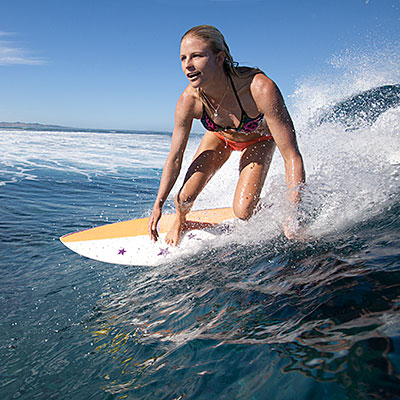
The summer I started taking surf lessons, I got caught in a powerful current. It pulled me down the beach until I was 15 yards from a shallow reef. If I stopped paddling, I would end up on the rocks, but my arms had turned to jelly and I could barely catch my breath. As I panicked, my instructor appeared beside me. “Grab my leash!” he shouted. I did, and he towed me to safety.
I was 31 and had recently moved to New York City for a fresh start after the end of a long relationship. Surfing was yet another adventure in my lifealthough after that experience, I stuck to baby waves, staying close to shore where my feet could touch the bottom. Some days, when the surf was rough, I’d just sit on the beach and watch others floating atop the swells.
I loved surfing more than any other activity I’d tried. The cold water against my skin, the weightlessness of my legs dangling off my board, the only sound a rhythmic hush: The ocean made me feel alive and fully immersed in the present.
But I couldn’t shake my jitters. It wasn’t just the power of the waves; I also worried about what might lurk beneath them. As Hunter S. Thompson wrote, “Civilization ends at the waterline. Beyond that, we all enter the food chain, and not always right at the top.”
Related: The 10 Most Slimming Vacations
Facing the Current
My anxiety was seeping into dry land, too. Overwhelmed by job pressures and life in the big city, I kept my head down and tried to blend in. I hardly knew my co-workers and spent most evenings hanging with my dog.
In search of a confidence boost, I headed off solo to Sayulita, a dusty fishing village on Mexico’s Pacific side, where a women-only surf camp called Las Olas offers a week of coaching on the local breaks. The first morning, as I joined the other 10 “campers” on the beach, I wondered what I’d gotten myself into. I’ve never been great at small talk and meeting new people; I’m more of a watchful, slow-to-warm-up type. But, as I reminded myself, the very reason I came was to get out of my comfort zone.
Once we were suited up, our instructors led the group into mellow rollers and critiqued us as we windmilled to catch waves, popped up on our boards and tumbled. Falling is a given, they assured usit’s how you get better.
Within a few days, we graduated to bigger swells. We kept wiping out and paddling back, all the while cheering each other on. At night we bonded over fresh fish and cervezas in local taquerias. Our group spanned three decades in age, yet that didn’t matter. I found myself opening up to these women who got the same chest flutter at the sight of a perfect curl, and it felt good to connect.
Taming the Beast
On our last day, we took a boat to a reef off a wild stretch of coast. My surfing had improved: I paddled more efficiently and felt more in control. But as I jumped into the water, a familiar unease sank in. I knew that the physics of reef breaks produces heavier waves. Paddling to the takeoff zone, I pictured a rogue monster lifting me and pounding my body onto the coral. I sat up, tears in my eyes.
Breathe. Trust. Stay calm. This was the moment I’d been waiting for. This was where I would find my guts. When a hump formed behind me, I went for it, and as I stood I could hear the ladies hooting and hollering from the boat.
Like all good break-throughs, this one came with an epiphany: I will always be humbled by the ocean, just as I will always be reserved around strangers and cautious in new situations. There was no sense in fighting my nature, I realized. For me, the trick to being brave is riding out my fears.
Soon after I got home, I decided to drive to the end of Long Island to Ditch Plains, one of the best breaks on the eastern coast. I had watched serious surfers here but never worked up the nerve to get in. Now I paddled out. As I turned to face the horizon, I saw a wave set beginning to rise. Breathe.
Related: 7 Must-Pack Vacation Items
So you want to try a surf vacation?
Domestic and international surf camps and schools abound; browse listings at surfcamps.com and surfertoday.com. If you’re a beginner, consider a camp that offers individual lessons and promises consistent, gentle waves. (Try Corky Carroll’s in Nosara, Costa Rica; Nancy Emerson’s in Oahu, Hawaii; or the one our editor attended, Las Olas in Sayulita, Mexico.) Bringing your ride? JetBlue has one of the cheapest feesjust $50 a board. Since the size of waves varies by season, research your destination and desired travel month; check out surfline.com.